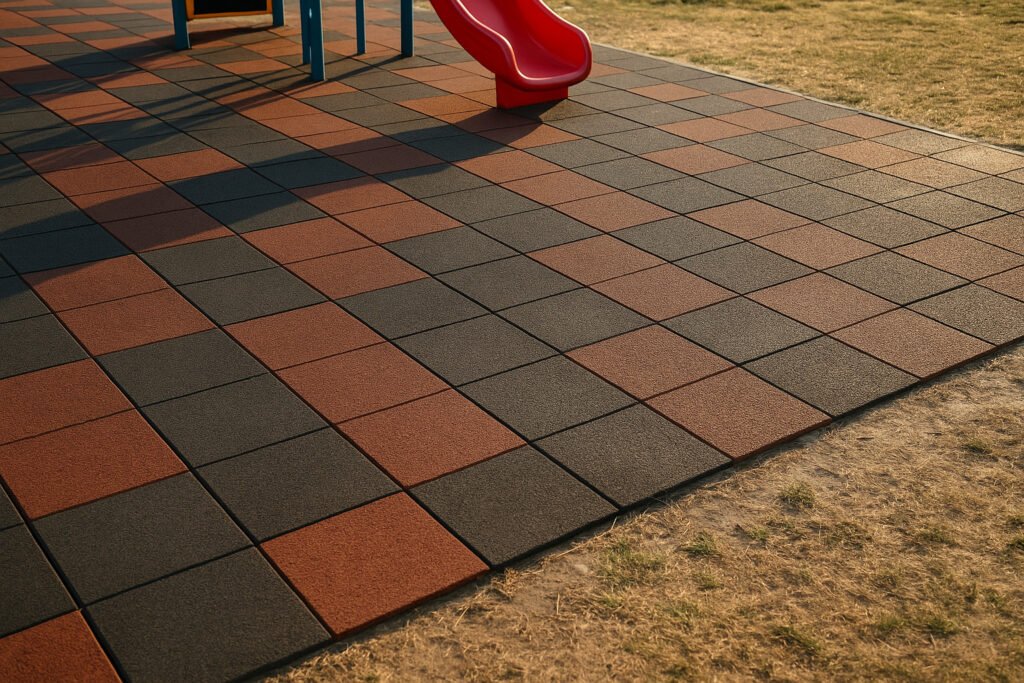Can You Lay Outdoor Tiles on Soil?
If you’re planning to install rubber tiles outside, you might wonder: Can I lay them directly on soil or sand?
While it’s possible for short-term or decorative use, laying outdoor tiles directly on soil is not recommended for long-term stability and safety.

Here’s what happens when you skip proper ground preparation—and how to do it the right way.
What Happens If You Lay Tiles Directly on Soil?
Soil is a soft and unstable base. Without proper compaction and drainage:
- Tiles may sink or shift with time and use
- Surface becomes uneven—a trip hazard especially for children
- Water pooling under tiles leads to mold or erosion
- Edges may curl, buckle, or crack under weight
While temporary event setups may tolerate it, it’s a risky option for playgrounds, walkways, or outdoor gyms.
Why a Stable Subbase Is Important
Rubber tiles are designed to sit on solid, flat ground. A weak base causes:
- Premature tile wear and detachment
- Safety hazards due to uneven levels
- Poor drainage and pooling beneath the surface
A solid subbase ensures your tiles stay even, safe, and durable for years.
Explore recommended solutions: Outdoor Rubber Floor
What Base Should You Use Under Outdoor Rubber Tiles?
| Base Type | Suitability | Notes |
|---|---|---|
| Loose Soil | ❌ Not Recommended | Unstable, can shift and absorb moisture |
| Sand (only) | ❌ Not Recommended | Easily washes away or compresses unevenly |
| Gravel + Sand | ✅ Good | For walkways/playgrounds, must be compacted |
| Concrete Slab | ✅✅ Best | Ideal for long-term, heavy-use zones |
| Asphalt | ✅ | Excellent drainage, durable for outdoors |
Learn how to do it properly: How to Prepare the Ground for Outdoor Rubber Flooring
Can You Lay Tiles Temporarily on Soil?
Yes—for short-term or low-traffic installations:
- Use interlocking puzzle tiles to prevent movement
- Level the soil as much as possible
- Consider placing weed barrier fabric + compacted sand below
👉 Suggested product: Puzzle Rubber Tile
This setup can work for:
- Temporary displays
- Garden paths
- Event flooring
But it’s not suitable for:
- Playgrounds with jumping children
- Outdoor gyms
- Wet areas with drainage needs
Tips for DIY Ground Prep on Soil
If you must use soil as the base:
- Remove grass and roots
- Install a weed barrier fabric
- Add 10–15cm compacted crushed gravel
- Top with 2–5cm of fine sand, leveled and compacted
- Edge the area to prevent lateral movement
Still not as reliable as concrete, but far better than bare dirt.
Related Guides for Installation
- How to Install Outdoor Rubber Flooring
- EPDM vs PU for Outdoor Flooring
- Choose the Right EPDM Granules
- Rubber Flooring Thickness Guide
Conclusion
You can lay tiles on soil—but only if it’s properly prepared. For safety, durability, and performance, we always recommend a solid subbase like compacted gravel or concrete.
Looking for help planning your outdoor project? Get in touch with us or browse all our products at www.lanhefloor.com
